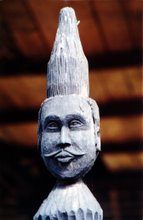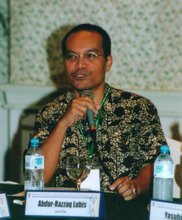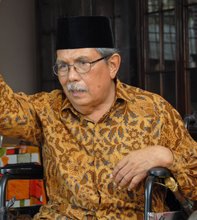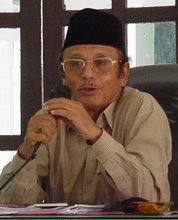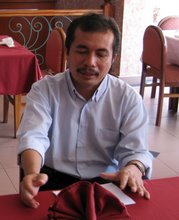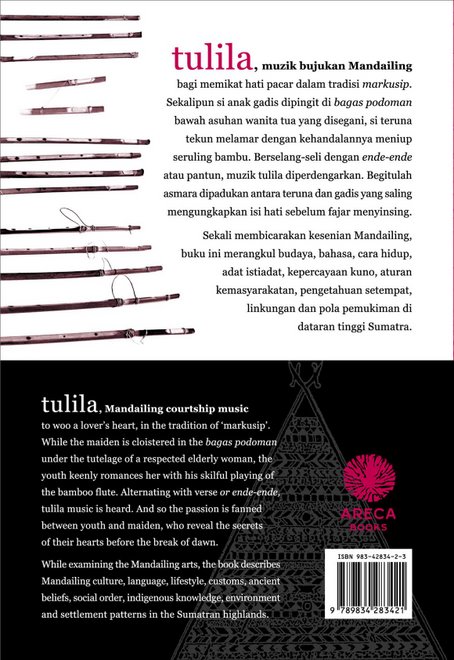
Malaysia Today: A Reflection
By M. Nadarajah
The idea of "Malaysia" is a contested one. There is no one single notion of Malaysia. We live in many "frames" of Malaysia. As in the case of most post-colonial societies that underwent change from a " sort of" mono-ethnic population to a definite multi-ethnic one, Malaysia is still in search of an identity.
Many amongst us have collectively tried to weave together, inspite of the many odds against us, a delicate and fragile national "socio-cultural fabric" in the effort to create an identity . And those among us who have felt at home among our families, friends and fellow citizens, to whatever degree, nurtured the motive guiding the weaving of the fabric - "a dialogically unified, a coexistential and inclusive multi-ethnic/cultural Malaysia". However, the events of our nation's recent past have ripped it cruelly here and there, causing the tenuous areas of coexistence to be thrown off track, if not destroyed altogether. Again. A periodic return to a state many of us want to move away.
Where do we start to trace the string of events of the recent past ? An examination of our recent past indicates socio-cultural and socio-political convulsions at the end of 2000 and the beginning of 2001. At the time in our nation's history when we had all the reasons and greater need to further strengthen our national commitment as a multi-ethnic/cultural society by a call for "Malaysian unity" talks. It would have contributed to and strengthened the efforts of weaving our fragile national socio-cultural fabric. It would have further encouraged the imagination of "Malaysia" as our common home, as a ground for a collective identity. And it would have moved the nation one more small step towards it.
But instead what did we do? A cursory examination of both the traditional and the new e-media reveal a focus on the Malays in recent times particularly centred on "Malay unity" talks, with a subsidiary concern for "Malay hegemony". A critical elaboration of these concerns seem to show some serious manifest and latent consequences.
The Malay unity talks arose out of UMNO's urgent need to address its loss of legitimacy among a growing number of the Malay people defined either by the specific practices of their religion, their association and support for Anwar Ibrahim, their notion of fairness and/or by their age/generation. The Malay unity talks were to set in motion a process that will in time come to displace PAS, and possibly Keadilan, and bring the Malay people back under the influence and leadership of UMNO. UMNO had to find ways to regain its lost legitimacy. In the dynamics of a modern multi-party based democratic system, this seems to be an acceptable strategy for any party to undertake. Why not?
But because of the special leadership position of the Malays in Malaysia, the historical context in which the need for Malay unity talks was embedded, among other factors, set in motion a string of intended and unintended events that seem to have taken an unfortunate trajectory , one that consolidates one frame of Malaysia as against others. The impersonal force of "fragmentation" has crystallised again and is visibly piercing through important parts of the nation , if not everywhere .
Around the time of the Lunas bye-election, Malaysia was caught up with a number of developments that seem to have adversely affected the "Malaysianisation" process. There was first the debate over "vision schools" with the Chinese community having a reservation about it, perhaps not so much about the idea itself as much as about the way it will be implemented. People in power and those associated with them took the community to task without reasonably addressing its fears.
Following closely on the heels of that was the issue of the "pleas/demands" of the Malaysian Chinese Organisations Election Appeals (Suqiu) Committee. The "pleas/demands" of Suqiu -- though not addressed critically during the election -- for that would have meant the possibility of loss of Chinese votes -- was addressed much later after the BN had won the election, again sometime around the end of 2000. The "pleas/demands" was supposedly unreasonable and anti-Malay. Naturally, groups like UMNO and Gabungan Pelajar Melayu Semenanjung (GPMS) attacked Suqiu to bring it down to its knees, though the community in all fairness made the pleas/demands from that position. GPMS even proposed a set of counter-demands, including gazetting the PM's position as one that should be available only for the Malays. These alignment of forces immediately transforms what are problems of governance and of policies into issues concerning race or race relations. As the problem with Suqiu was in progress and reaching a crescendo, UMNO set in motion on the need for talks on "Malay unity".
The Malay unity talks in the context of what was going on prior and at the time it was proposed sent a definite signal to the non-Malays. The ethno-culturescape underwent a convulsion. Malaysianisation was pushed aside as "Malay-sianisation" was being re- mobilised.
It is perhaps worthwhile keeping mind here the issue of Malay hegemony. Firstly, the Malay hegemony issue addressed the position of Malays in the context of multi-ethnic Malaysia. Secondly, an area not usually addressed involved the classification of "Malay", which is by itself a hegemonic process. Like the classification of "bumiputeras", the "Malay community" is really a collection of a number of communities. For instance, the Mandailings are classified as Malays. Ask a "Mandailing" privately and s/he will probably not agree with that classification. There is a belief among them that they are a different people. So we have "Minang", "Kelantanese", "Penang Mamak", "Achenese", etc who are all classified as Malay. Such a hegemonic classification has a political function.
To continue, Malay hegemony in the first instance cited above, is seen as a function of Malay nationalism. The underlying assumption of Malay hegemony is the belief that Malaysia is part of the Malay world and that the Malays must necessarily have "more" rights - symbolic or real -- than the others in the country. It is, after all, "tanah Melayu". Their numbers and their control of important institutions provide the community the power to establish hegemonic status.
To offer the other communities equal status in every aspect is politically and culturally inadvisable, as it may upset the hegemonic status of the Malay community and take the "tanah Melayu" away from them. Given this scenario, post-colonial Malaysia as an emotional reality will, for a long, long time, be a contestation between "Malaysia" and "Malay--sia". And certain variations within these frames. The "voices" that are heard only make sense within the context of these frames.
Against this critical background, one can see how this nation's recent history has forced the fragile ethno-cultural reality, centred on an imagination of a dialogically unified, a coexistential and inclusive multi-ethnic/cultural Malaysia to break like a looking glass mirror, into hundreds of pieces. One image into many. An unfortunate fragmentation process had again clocked in.
The first fragmentation: the idea of Malay unity talks re-affirmed the "Malay - Non-Malay" ethno-cultural and religious fields. It made the point that we are not in Malaysia but in "Malay-sia". Like a child who must commit a lesson to memory, we are periodically made to remember the "Malay - Non-Malay" (or bumiputeras - non-bumiputera) divide, never allowed to create a new consciousness of a possible alternative future.
In addition to the above consequence of the Malay unity talks, the non-Malay communities were also positioned as silent spectators to a spectacle. The Malay unity talks were as much for non-Malay consumption as it was for the consumption of the majority of Malays.
At another level, given our ability to petty politicise everything, the consequences of the representation of Suqiu pleas/demands as unreasonable and anti-Malay should have allowed itself to be interpreted as an external threat to "Malay-sianisation", a factor critically important for intra-communal bonding and perhaps also contribute to and help crystallise the Malay unity talks.
To this problem faced by members of the Chinese community was another serious one that directly affected their children. Our children. This relates to the problem of the Damansara Chinese Primary School, built with community donations 71 years ago. It was to be closed because of its close proximity to a highway. Parents were unhappy. Children were unhappy.
The second fragmentation: Many Chinese Malaysian became "Chinese in Malay--sia". Again. Even as the need for Malay unity talks proceeded, the "Malay-sianisation" was in progress, re-shaping and consolidating "Malay-sia".
Whether or not the Malay unity talks will be eventually held and whether or not the expected results will be achieved, the impact and consequences of the proposal for such talks are visible, if one only cares to look. Did the process of fragmentation stop, with the Chinese committing to their memory that they are Chinese in "Malay-sia"? Hardly. It seems to have continued steadily -- like an arrow from an unknown source looking for its helpless victim -- into the harsh squatter reality of Kampong Medan and its vicinity-- something that reflects the failure of this government to reach the poor, their livelihoods and their living environments. Whatever the specificities of the problem were, another instance of fragmentation was in place.
This fragmentation is being achieved not by confronting a reasonable set of pleas/demands by an unreasonable counter-demand at the level of consciousness and/or strategy. But, by driving deep into the flesh, bones and psyche of many innocent Malaysians, an experience of bloody, intense pain . The body in pain interprets the world in the language of "us" and "them", of faultlines and of separation.
The third fragmentation: Many Indian Malaysians begin to feel insecure and become "Indians in Malay--sia". Again.
The dominant cycle involving the three major communities is complete. The "Malay-sianisation" process is re-established with a vengeance. The symbolic territories of the communities are now re-defined in space and /or time. The "Malay unity" talks will hail the Malays. "Damansara" and "education" will hail the "Chinese in Malay--sia" while the "squatter", "University Hospital"and the "prison" will hail the "Indians in Malay--sia". This periodic, culturally and/or economically motivated, political hailing, like religious hailing, will bring the individual members of the communities together, but unlike religious hailing, will keep the communities separate and fragmented.
It is back again to square one -- in that struggle to define ourselves, to seek an identity that is consistent with our "feeling at home" within the career of the two main frames, "Malaysia" or "Malay--sia". They produce different subjects and they offer different trajectories, different futures. Do we have the wisdom today to make a choice of the collective future we want, a future that is democratically participatory and deliberative from the local level upwards, culturally rich with diversity, and socially inclusive institutionally?
M. Nadarajah
Kuala Lumpur
26th March 2001
By M. Nadarajah
The idea of "Malaysia" is a contested one. There is no one single notion of Malaysia. We live in many "frames" of Malaysia. As in the case of most post-colonial societies that underwent change from a " sort of" mono-ethnic population to a definite multi-ethnic one, Malaysia is still in search of an identity.
Many amongst us have collectively tried to weave together, inspite of the many odds against us, a delicate and fragile national "socio-cultural fabric" in the effort to create an identity . And those among us who have felt at home among our families, friends and fellow citizens, to whatever degree, nurtured the motive guiding the weaving of the fabric - "a dialogically unified, a coexistential and inclusive multi-ethnic/cultural Malaysia". However, the events of our nation's recent past have ripped it cruelly here and there, causing the tenuous areas of coexistence to be thrown off track, if not destroyed altogether. Again. A periodic return to a state many of us want to move away.
Where do we start to trace the string of events of the recent past ? An examination of our recent past indicates socio-cultural and socio-political convulsions at the end of 2000 and the beginning of 2001. At the time in our nation's history when we had all the reasons and greater need to further strengthen our national commitment as a multi-ethnic/cultural society by a call for "Malaysian unity" talks. It would have contributed to and strengthened the efforts of weaving our fragile national socio-cultural fabric. It would have further encouraged the imagination of "Malaysia" as our common home, as a ground for a collective identity. And it would have moved the nation one more small step towards it.
But instead what did we do? A cursory examination of both the traditional and the new e-media reveal a focus on the Malays in recent times particularly centred on "Malay unity" talks, with a subsidiary concern for "Malay hegemony". A critical elaboration of these concerns seem to show some serious manifest and latent consequences.
The Malay unity talks arose out of UMNO's urgent need to address its loss of legitimacy among a growing number of the Malay people defined either by the specific practices of their religion, their association and support for Anwar Ibrahim, their notion of fairness and/or by their age/generation. The Malay unity talks were to set in motion a process that will in time come to displace PAS, and possibly Keadilan, and bring the Malay people back under the influence and leadership of UMNO. UMNO had to find ways to regain its lost legitimacy. In the dynamics of a modern multi-party based democratic system, this seems to be an acceptable strategy for any party to undertake. Why not?
But because of the special leadership position of the Malays in Malaysia, the historical context in which the need for Malay unity talks was embedded, among other factors, set in motion a string of intended and unintended events that seem to have taken an unfortunate trajectory , one that consolidates one frame of Malaysia as against others. The impersonal force of "fragmentation" has crystallised again and is visibly piercing through important parts of the nation , if not everywhere .
Around the time of the Lunas bye-election, Malaysia was caught up with a number of developments that seem to have adversely affected the "Malaysianisation" process. There was first the debate over "vision schools" with the Chinese community having a reservation about it, perhaps not so much about the idea itself as much as about the way it will be implemented. People in power and those associated with them took the community to task without reasonably addressing its fears.
Following closely on the heels of that was the issue of the "pleas/demands" of the Malaysian Chinese Organisations Election Appeals (Suqiu) Committee. The "pleas/demands" of Suqiu -- though not addressed critically during the election -- for that would have meant the possibility of loss of Chinese votes -- was addressed much later after the BN had won the election, again sometime around the end of 2000. The "pleas/demands" was supposedly unreasonable and anti-Malay. Naturally, groups like UMNO and Gabungan Pelajar Melayu Semenanjung (GPMS) attacked Suqiu to bring it down to its knees, though the community in all fairness made the pleas/demands from that position. GPMS even proposed a set of counter-demands, including gazetting the PM's position as one that should be available only for the Malays. These alignment of forces immediately transforms what are problems of governance and of policies into issues concerning race or race relations. As the problem with Suqiu was in progress and reaching a crescendo, UMNO set in motion on the need for talks on "Malay unity".
The Malay unity talks in the context of what was going on prior and at the time it was proposed sent a definite signal to the non-Malays. The ethno-culturescape underwent a convulsion. Malaysianisation was pushed aside as "Malay-sianisation" was being re- mobilised.
It is perhaps worthwhile keeping mind here the issue of Malay hegemony. Firstly, the Malay hegemony issue addressed the position of Malays in the context of multi-ethnic Malaysia. Secondly, an area not usually addressed involved the classification of "Malay", which is by itself a hegemonic process. Like the classification of "bumiputeras", the "Malay community" is really a collection of a number of communities. For instance, the Mandailings are classified as Malays. Ask a "Mandailing" privately and s/he will probably not agree with that classification. There is a belief among them that they are a different people. So we have "Minang", "Kelantanese", "Penang Mamak", "Achenese", etc who are all classified as Malay. Such a hegemonic classification has a political function.
To continue, Malay hegemony in the first instance cited above, is seen as a function of Malay nationalism. The underlying assumption of Malay hegemony is the belief that Malaysia is part of the Malay world and that the Malays must necessarily have "more" rights - symbolic or real -- than the others in the country. It is, after all, "tanah Melayu". Their numbers and their control of important institutions provide the community the power to establish hegemonic status.
To offer the other communities equal status in every aspect is politically and culturally inadvisable, as it may upset the hegemonic status of the Malay community and take the "tanah Melayu" away from them. Given this scenario, post-colonial Malaysia as an emotional reality will, for a long, long time, be a contestation between "Malaysia" and "Malay--sia". And certain variations within these frames. The "voices" that are heard only make sense within the context of these frames.
Against this critical background, one can see how this nation's recent history has forced the fragile ethno-cultural reality, centred on an imagination of a dialogically unified, a coexistential and inclusive multi-ethnic/cultural Malaysia to break like a looking glass mirror, into hundreds of pieces. One image into many. An unfortunate fragmentation process had again clocked in.
The first fragmentation: the idea of Malay unity talks re-affirmed the "Malay - Non-Malay" ethno-cultural and religious fields. It made the point that we are not in Malaysia but in "Malay-sia". Like a child who must commit a lesson to memory, we are periodically made to remember the "Malay - Non-Malay" (or bumiputeras - non-bumiputera) divide, never allowed to create a new consciousness of a possible alternative future.
In addition to the above consequence of the Malay unity talks, the non-Malay communities were also positioned as silent spectators to a spectacle. The Malay unity talks were as much for non-Malay consumption as it was for the consumption of the majority of Malays.
At another level, given our ability to petty politicise everything, the consequences of the representation of Suqiu pleas/demands as unreasonable and anti-Malay should have allowed itself to be interpreted as an external threat to "Malay-sianisation", a factor critically important for intra-communal bonding and perhaps also contribute to and help crystallise the Malay unity talks.
To this problem faced by members of the Chinese community was another serious one that directly affected their children. Our children. This relates to the problem of the Damansara Chinese Primary School, built with community donations 71 years ago. It was to be closed because of its close proximity to a highway. Parents were unhappy. Children were unhappy.
The second fragmentation: Many Chinese Malaysian became "Chinese in Malay--sia". Again. Even as the need for Malay unity talks proceeded, the "Malay-sianisation" was in progress, re-shaping and consolidating "Malay-sia".
Whether or not the Malay unity talks will be eventually held and whether or not the expected results will be achieved, the impact and consequences of the proposal for such talks are visible, if one only cares to look. Did the process of fragmentation stop, with the Chinese committing to their memory that they are Chinese in "Malay-sia"? Hardly. It seems to have continued steadily -- like an arrow from an unknown source looking for its helpless victim -- into the harsh squatter reality of Kampong Medan and its vicinity-- something that reflects the failure of this government to reach the poor, their livelihoods and their living environments. Whatever the specificities of the problem were, another instance of fragmentation was in place.
This fragmentation is being achieved not by confronting a reasonable set of pleas/demands by an unreasonable counter-demand at the level of consciousness and/or strategy. But, by driving deep into the flesh, bones and psyche of many innocent Malaysians, an experience of bloody, intense pain . The body in pain interprets the world in the language of "us" and "them", of faultlines and of separation.
The third fragmentation: Many Indian Malaysians begin to feel insecure and become "Indians in Malay--sia". Again.
The dominant cycle involving the three major communities is complete. The "Malay-sianisation" process is re-established with a vengeance. The symbolic territories of the communities are now re-defined in space and /or time. The "Malay unity" talks will hail the Malays. "Damansara" and "education" will hail the "Chinese in Malay--sia" while the "squatter", "University Hospital"and the "prison" will hail the "Indians in Malay--sia". This periodic, culturally and/or economically motivated, political hailing, like religious hailing, will bring the individual members of the communities together, but unlike religious hailing, will keep the communities separate and fragmented.
It is back again to square one -- in that struggle to define ourselves, to seek an identity that is consistent with our "feeling at home" within the career of the two main frames, "Malaysia" or "Malay--sia". They produce different subjects and they offer different trajectories, different futures. Do we have the wisdom today to make a choice of the collective future we want, a future that is democratically participatory and deliberative from the local level upwards, culturally rich with diversity, and socially inclusive institutionally?
M. Nadarajah
Kuala Lumpur
26th March 2001
